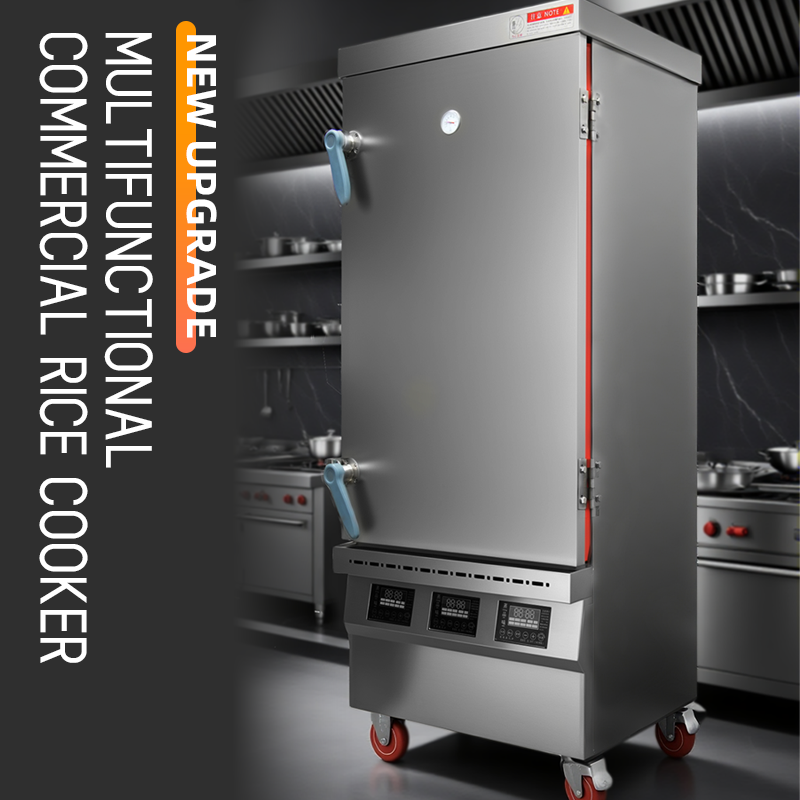A steam cabinet (also known as a steam cabinet or steam holding cabinet) is a specialized appliance that uses high-temperature steam to heat or hold food. It is widely used in the food service industry (such as hotels, cafeterias, and fast food restaurants) and in home kitchens. The following is a detailed description of its core features and operating principles:
I. How a Steam Cabinet Works
1. Steam Generation:
The water in the tank is heated to boiling using built-in electric heating elements or an external boiler/steam source, producing saturated steam (typically between 100°C and 120°C).
2. Circulating Heating:
The steam is evenly distributed through pipes within the cabinet's enclosed space, efficiently penetrating the food using the steam's latent heat, preventing overheating or undercooking.
3. Temperature Control System:
Modern steam cabinets are equipped with intelligent thermostats that precisely adjust the temperature (e.g., 100°C for steaming mode and 60-80°C for holding mode). Some models also support a timer function.
II. Core Functions and Advantages of Steam Cabinets
Fast Cooking
High-temperature steam cooks food (such as buns, fish, and vegetables) thoroughly in 5-15 minutes, far exceeding traditional steamers and saving time and energy.
Uniform heating
Steam circulates seamlessly, preventing uneven drying and wetting of food. This preserves the original flavor of ingredients, ensuring a fresh, juicy texture.
Retains moisture
In keep-warm mode, a continuous stream of steam is released to prevent food from drying out and freezing. Suitable for banquets, buffets, and other settings.
Healthy Cooking
Oil-free and smoke-free, reducing nutrient loss (e.g., vitamin retention is 30% higher than boiling). This meets the needs of a low-fat, healthy diet.
Versatile Applications: In addition to steaming, it can also defrost ingredients, ferment dough, and sterilize tableware. This multi-purpose appliance improves space utilization.
Main Types of Steam Cabinets
By Usage:
Commercial Steam Cabinets: Large capacity (commonly 3-10 compartments), stainless steel, and high power (5-15kW), suitable for restaurant kitchens. Home Steam Cabinets: Compact (1-3 layers), energy-efficient (1-3kW), with integrated smart menus.
By steam source:
Direct injection: Built-in heater for easy operation (mainstream for home use).
External steam: Requires connection to a boiler for higher power (common for commercial use).
IV. Typical Applications of Steam Cabinets
Catering:
Steaming dim sum (shrimp dumplings, siomai), seafood, and rice.
Keeping banquet dishes warm in batches (such as whole fish and soups).
Home:
Healthy breakfasts (frozen buns, whole grains), sterilizing baby food.
Microwave alternative to heating, preventing food loss.
V. Global and Regional Market Size of Steam Cabinets
Global Market: US$4.2 billion, 6.8% (2024-2030)
Restaurant chain expansion and healthy cooking trends
China Market: RMB 7.8 billion, 12.5% (leading the world)
Expansion of the food delivery industry and the prevalence of central kitchens
North American Market: US$930 million, 4.2%
Demand from the fast food industry and commercial kitchen renovations
European Market: €650 million, 5.1%
Upgraded food hygiene regulations and energy-saving policies
Note: China's household steam cabinet market is expected to grow by 18% (2023 data), driven by rising health awareness and demand for smaller apartments.
Core Market Drivers:
Efficiency Revolution in the Restaurant Industry
The Takeout Boom: The global takeout market exceeds US$200 billion, and steam cabinets' 5-minute food delivery capabilities have become a necessity for fast food restaurants.
Increasing Chainization: China's restaurant chainization rate has risen from 15% (2018) to 21% (2023), spurring a surge in demand for standardized equipment. Labor Cost Pressure: Steam cabinets reduce kitchen labor by 30%, and their penetration rate in Japan's catering industry has reached 65%.
Globalization of Healthy Diet
Low-Fat Cooking Trend: Sales of steaming equipment are driving growth in Europe and the United States (e.g., 23% growth in the US by 2023).
Demand for Nutrient Retention: The market for infant and toddler solid food and elderly meals is expanding, and steam cabinets with a vitamin retention rate of >90% are a key selling point.
Technological Progress and Cost Reduction
Energy-Saving Technology: New variable-frequency steam generators reduce energy consumption by 40%, shortening the payback period for commercial machines to 8-12 months.
Smart IoT: 70% of high-end models support app-controlled steaming curves (e.g., scheduling dough fermentation).
Competitive Landscape and Brand Strategy
Commercial
Lechuang, Xinmai, and Wanzhuo: Large Capacity + Customization (Compatible with Central Kitchen Systems)
Home
Midea, Supor, and Fotile: Integrated (Combination Steamers and Ovens account for over 50%)
Foreign
Rational (Germany), APW (USA): High-End Intelligence (AI Temperature Control, Self-Cleaning)
Innovation Cases:
AI Steam Cabinets Use Image Recognition to Automatically Adjust Steaming Time for Seafood
Rational Launches Hydrogen-Oxygen Hybrid Steam Technology, Saving 30% Energy and Enhancing Food Freshness
VII. Future Trend Forecast
Technology Integration
Modular Design: Steam cabinet + oven + fryer combination appliances are becoming mainstream in commercial applications (e.g., McDonald's kitchen upgrades).
Green Energy Adaptation: Solar thermal storage steam systems receive EU subsidies (target 30% coverage by 2030).
Expanding Application Scenarios
Pre-prepared Meal Support: Purchases of steam cabinets by Chinese pre-prepared meal factories are increasing by 35% (for freshness preservation and reheating). Medical/Elderly Care Applications: Japan develops medical steam cabinets to achieve nutritional enrichment and sterile processing for liquid food.
Market Differentiation
High-end Commercial Use: Smart IoT + Blockchain Traceability (recording the steaming process of ingredients).
Lower-tier Market: Penetration rate of household steamers priced below ¥1,000 in county markets exceeds 20% (2023 data).
VIII. Challenges and Responses
Controversy surrounding high energy consumption: Promoting condensate recovery technology (saving 25%)
Insufficient education in the household market
Customized steaming programs with recipe apps
Homogeneous competition
Developing scenario-based Pu'er tea steam curing models
VI. Investment Hotspots
Southeast Asia: Expansion of the catering industry and export of Chinese food culture (32% increase in steam cabinet imports in Vietnam/Thailand).
China's third- and fourth-tier cities: Steam cabinets can replace traditional steamers (estimated penetration rate 35% in 2025).
North American Fast Food Supply Chain: Companies such as Burger King invest $120 million to upgrade their steam insulation systems. Data Insight: By 2030, the global steam cabinet market is expected to exceed US$6 billion, with smart models accounting for over 40%. Energy-saving technology will become a barrier to entry. Focus on innovative areas such as integration, modularization, and hydrogen steam.


